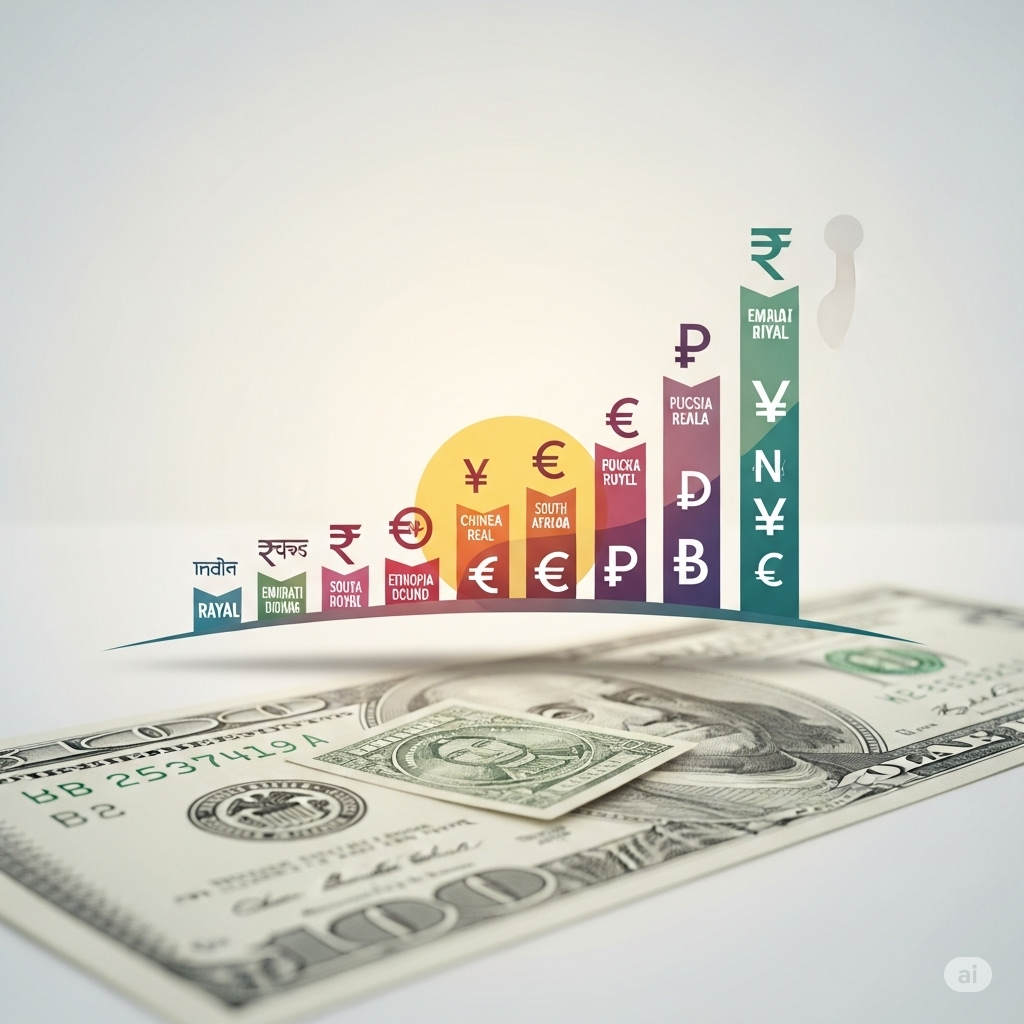
- The 17th BRICS Summit held under the theme “Global South for Global Order,” marked a pivotal moment in the bloc’s campaign to redefine global economic structures.
- The Rio Summit placed de-dollarisation at the table of BRICS’ collective strategy.
- In the foreseeable future, the world is more likely to witness currency diversification rather than a full dethroning of the dollar.
- For BRICS, the real success may lie not in replacing the dollar overnight, but in building credible alternatives that signal the gradual erosion of a single-currency monopoly.
Introduction
The 17th BRICS Summit, held in Rio de Janeiro, Brazil, from July 6–7, 2025, under the theme “Global South for Global Order,” marked a pivotal moment in the bloc’s campaign to redefine global economic structures. With the inclusion of new members—Egypt, Ethiopia, Indonesia, Iran, the United Arab Emirates, and Saudi Arabia—alongside founding members Brazil, Russia, India, China, and South Africa, the expanded BRICS bloc articulated a clear ambition: to reduce dependence on the U.S. dollar in global trade and finance. Brazilian President Luiz Inácio Lula da Silva encapsulated this vision, stating, “The world needs to find a way that our trade relations don’t have to pass through the dollar,”[1] drawing parallels to the spirit of the Non-Aligned Movement during the Cold War.
The Rise of the Dollar: From Bretton Woods to Petrodollars
The dominance of the U.S. dollar didn’t happen by chance; it was forged by war, strategic policy, and global trust in American financial institutions. After World War II, as Europe lay in ruins and much of the world struggled to rebuild, the United States emerged as the largest economy and the biggest holder of gold reserves. At the 1944 Bretton Woods Conference[2], nations agreed to peg their currencies to the U.S. dollar, which itself was pegged to gold. This arrangement created a stable framework for international trade, and the dollar became the backbone of the new global monetary order.
When the U.S. ended gold convertibility in 1971 (Nixon Shock)[3], the dollar retained its central role due to deep U.S. financial markets, trust in American institutions, and sheer inertia. A key milestone came in 1974 when the U.S. struck a deal with Saudi Arabia to price oil exclusively in dollars. This “petrodollar”[4] system compelled oil-importing countries to hold dollars, reinforcing global dollar demand.
This monetary supremacy allowed the United States not only economic leverage but also strategic power, particularly through control of financial infrastructure like SWIFT. It has enabled Washington to impose economic sanctions and restrict access to markets—tools increasingly contested by emerging economies.
The De-Dollarisation Agenda at the Rio Summit?
The global financial system is showing early signs of transition. Countries are experimenting with bilateral trade in local currencies, building regional financial systems, and questioning the fairness of a dollar-centric world.
The Rio Summit placed de-dollarisation at the table of BRICS’ collective strategy. The bloc reiterated its push for trade and finance in local currencies through mechanisms like the BRICS Interbank Cooperation Mechanism (ICM). This institutional tool, linking national development banks, aims to facilitate cross-border transactions in currencies such as the Indian rupee (INR), Chinese yuan (CNY), Brazilian real (BRL), South African rand (ZAR), and the Emirati dirham (AED). Russian President Vladimir Putin highlighted the relevance of this shift, noting that 90% of Russia’s trade with BRICS members in 2024 was settled in national currencies.[5]
This effort builds upon foundations laid at previous summits, especially the 2024 Kazan Summit, which also called for the development of independent payment systems and alternative financial networks insulated from U.S.-centric mechanisms. The Kazan Declaration criticised “unlawful and coercive unilateral measures” and underscored how dependence on dollar-based infrastructure exposes countries to arbitrary disruptions when they diverge from Western geopolitical interests.
Sanctions as a Catalyst for Currency Diversification
The dollar’s ubiquity gives the U.S. immense financial and geopolitical power. Because most trade and financial transactions pass through American banks or systems, an “exorbitant privilege”, as termed by Valery Giscard d’Estaing, former Minister of France, the U.S. can unilaterally impose sanctions that have global reach. The United States’ use of sanctions has emerged as a double-edged catalyst for de-dollarisation. Following Russia’s invasion of Ukraine in 2022, U.S. sanctions froze approximately $300 billion of Russian sovereign assets held in the West[6]—illustrating the geopolitical vulnerabilities tied to dollar reliance. Similarly, Iran has long faced sanctions and has increasingly turned to alternative currencies and barter systems, and all governments placing their “petrodollar surpluses” in the United States may lose part of their economic and political independence. Consequently, the more petrodollar surpluses are placed in the United States by a certain oil-exporting nation, the less independent such a nation becomes.
This pattern extends beyond Russia and Iran to countries like Venezuela, North Korea, and, in some cases, even China. Denial of access to global banking infrastructure and restrictions on investment have led these nations to seek alternatives to the dollar, further legitimising the BRICS push for a parallel financial architecture.
Common Currency and Conflicting Interest
Russia and China have emerged as the most vocal proponents of a BRICS-issued common currency, viewing it as a strategic countermeasure to what they perceive as the dollar’s hegemonic grip on international trade and finance. Both nations have actively pushed for de-dollarisation in response to sanctions, geopolitical pressure, and the weaponisation of the dollar by the West. Recently, Chinese spokesperson Mao Ning criticised tariffs in a tweet, calling them tools of “coercion”.
This urgency, however, is not equally shared across the bloc. Other member states like India, Brazil, and South Africa have adopted a more cautious and measured approach. Their hesitation stems not only from practical and economic concerns but also from the complex geopolitical dynamics within the bloc—especially India’s wary stance toward China, given their contentious border disputes and strategic rivalry in Asia.
India has advocated for a feasibility study on a common currency—excluding China—as a possible alternative framework[7]. This move, initiated before the 2024 Kazan Summit, highlights India’s preference for strategic autonomy and its effort to prevent Beijing from exerting outsized influence within the bloc’s financial mechanisms. The proposal underscored New Delhi’s concerns about economic dependency on a currency architecture dominated by China, whose economic model and ambitions often clash with Indian interests.
Despite the increasing rhetoric on de-dollarisation, experts, including South African Reserve Bank Governor Lesetja Kganyago, have highlighted the structural hurdles in creating a BRICS currency. He pointed out that such a currency would require deep institutional integration, including a banking union, a fiscal union, and macroeconomic convergence[8]—none of which currently exist among BRICS members. These foundational gaps significantly undermine the feasibility of a common currency in the short to medium term.
In 2024, BRICS nations recorded international trade worth $10.5 trillion. India’s imports from the BRICS nations rose from 35% in 2020 to 43% in 2024, underscoring growing economic reliance.
While BRICS lacks a unified de-dollarisation policy, India has already expanded bilateral trade in local currencies. In June, at the India–Central Asia Business Dialogue, EAM S. Jaishankar reiterated India’s push for local currency trade to boost financial resilience.
While the BRICS nations share a common desire to reduce dependence on the dollar, the pathway to a viable alternative remains riddled with political, economic, and institutional complexities. Until this day, the absence of robust financial integration has kept a common BRICS currency a distant aspiration. Yet, the growing use of local currencies in trade acts as a quiet grasscutter, steadily trimming the overgrowth of dollar dominance — perhaps paving the way for a different future.
Expansion and Geopolitical Weight
The inclusion of new members—particularly energy-heavyweights like Saudi Arabia and the UAE, and strategically located nations like Egypt and Ethiopia—broadens BRICS’ geopolitical influence. This expansion underscores a shift toward a coalition capable of challenging Western-dominated governance systems in energy, trade, and finance. While symbolic in many respects, the enlargement increases the bloc’s economic clout and accelerates discussions on payment systems, trade corridors, and digital finance alternatives.
Challenges and Contradictions
Despite the momentum, BRICS faces significant structural and operational challenges that complicate the de-dollarisation agenda:
- Entrenched Dollar Dominance: As of 2025, the U.S. dollar remains involved in nearly 88% of global foreign exchange transactions and holds over 50% of global reserves[9].
- Fragmented Economies: Varying interest rates, capital controls, and inflation rates across BRICS members hinder harmonised monetary policy or financial integration.
- Market Confidence: The U.S. dollar is underpinned by strong institutions, deep markets, and regulatory transparency—attributes BRICS currencies have yet to consistently match.
Institutional Ambitions: From Reform to Resilience
BRICS’ ambitions go beyond currency diversification. The summit emphasised a multipolar global order through broader institutional reforms and stronger South-South cooperation:
- Reforming Global Financial Institutions: BRICS has consistently called for more equitable representation in institutions like the IMF and World Bank, which they argue reflect outdated power structures.
- Enhancing Economic Sovereignty: By facilitating bilateral trade in national currencies, BRICS nations aim to insulate themselves from external financial shocks and geopolitical pressure.
- Promoting the Global South: Through initiatives like the New Development Bank (NDB), BRICS is expanding infrastructure financing and development support to less-represented nations in Africa, Asia, and Latin America.
To be a Hedge, Not a Revolution
Although challenges to the dollar’s dominance are not new on the global stage, earlier efforts were abruptly halted following the untimely deaths of their key advocates. Leaders like Saddam Hussein and Muammar Gaddafi had pushed for alternatives to the U.S. dollar in trade and financial transactions, but their proposals vanished alongside them. After a brief pause in history, the push for de-dollarisation has once again resurfaced on the world stage.
The BRICS campaign to challenge the dollar-led financial system is grounded in legitimate aspirations for greater autonomy, equity, and resilience. However, declarations alone cannot overturn decades of entrenched monetary norms. The bloc’s initiatives—including the ICM, NDB, and local currency trade—represent important steps toward greater financial independence, but the transition will be slow, fragmented, and fraught with challenges.
In the foreseeable future, the world is more likely to witness currency diversification rather than a full dethroning of the dollar. The U.S. dollar will remain dominant but perhaps no longer unchallenged. For BRICS, the real success may lie not in replacing the dollar overnight, but in building credible alternatives that signal the gradual erosion of a single-currency monopoly. As such, BRICS’ agenda reflects less a revolution than a strategic hedge against a system they no longer trust to be neutral. As South African President Cyril Ramaphosa clarified, BRICS “does not seek to compete with any other power”, signalling the bloc’s pursuit of independent economic aspirations rather than being labelled as “Anti-American policies”
References:
- [1] https://www.hindustantimes.com/world-news/us-news/we-don-t-want-an-emperor-lula-tells-trump-after-us-tariff-threat-to-brics-101751916975322.html
- [2] https://2001-2009.state.gov/r/pa/ho/time/wwii/98681.htm
- [3] https://history.state.gov/milestones/1969-1976/nixon-shock
- [4] https://faculty.georgetown.edu/imo3/petrod/define.htm
- [5] https://economictimes.indiatimes.com/news/india/putin-calls-for-brics-wide-independent-settlement-system-using-national-currencies/articleshow/122287356.cms?from=mdr
- [6] https://www.theguardian.com/world/2025/may/31/ukraine-must-urgently-be-given-the-300bn-of-frozen-russian-assets
- [7] https://www.business-standard.com/finance/news/india-decides-to-study-the-proposal-for-brics-currency-minus-china-124022001282_1.html?ref=finshots.in
- [8] https://www.reuters.com/markets/currencies/what-is-brics-currency-is-us-dollar-trouble-2024-12-17/
- [9] https://www.cfr.org/backgrounder/dollar-worlds-reserve-currency
Sughosh Joshi is a CA Finalist and B.Com graduate with a strong interest in economics, geopolitics, and the analysis of international affairs, particularly those impacting India. Views expressed are the author’s own.
